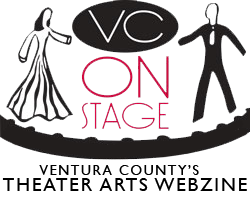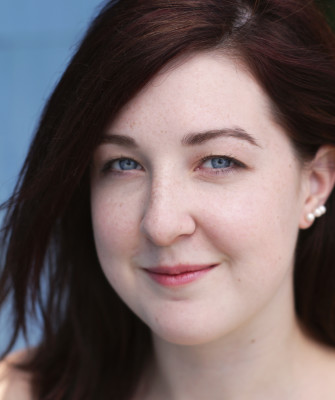BY CARY GINELL
Passion and perseverance is how you describe Julie Alice Auxier’s attitude toward dancing. Born in Dallas, Auxier (which rhymes with “walks away”), 25, is one of those individuals who burns with devotion to her art. Her work in High Street Arts Center’s production of Guys and Dolls marks her first experience choreographing a musical. We spoke with her after the successful opening weekend of the show.
VCOS: How long have you known you wanted to be a dancer?
JULIE: I started dancing at age 3 when my parents enrolled me and my sister in ballet class, and it stuck. I always found a way to dance, no matter where I was or what I was doing. It didn’t have to be ballet; I’ve danced so many different styles and loved every one. I found some kind of joy in each one of them. Musical theater is wonderful because there are so many different aspects of it and so many different styles incorporated into it. It’s wonderful to be back in that, choreographing, and finding all these different things I can draw from.
VCOS: Where did you go to school?
JULIE: I’m actually an engineer, which is not quite the traditional way to become a dancer. I went to Oregon State University for bioengineering and got my master’s in chemical engineering – very not dance-related! But all that time, I was dancing.
VCOS: So you never had any formal training in school?
JULIE: Just private studies in studios. From middle school to high school I did kick line drill team in Texas. That was intense. We danced six days a week, performed at Friday football games and competitions. I didn’t get a degree in dance but that hasn’t stopped me. I hope it won’t ever stop me.
VCOS: What goes into developing choreography for a show? What’s the first thing that you do?
JULIE: I look at my dancers, who I have, and what I have to work with. When I choreograph, the movement comes from my dancers. I get inspired by them; how they move, what qualities they have, and what they can bring. Like an artist, when you’re doing some kind of painting, you look at your medium and what you have to work with, and that’s how you express what you’re trying to get across.
VCOS: What about what has traditionally been done for Guys and Dolls? How does that fit in? Did you study Michael Kidd’s choreography from the original production?
JULIE: I looked mostly at the revival. That’s where Chris [note: director Christopher Mahr] wanted to base it off of because the revival is very bright and colorful and you have all these hard-hitting movements. Everything is bigger than life. So that was the goal. How to put that into movements is challenging, but the cast really stepped up to that and they have exceeded every expectation.
VCOS: Do you storyboard your choreography? Is everything spelled out when you start rehearsing?
JULIE: It is. Every choreographer is different in how they write down their thoughts. It’s not like writing music; there’s no codified way to do it. I’m very systematic; that’s the engineer in me, I guess, in how I count everything out, how I plan it, where I want people. I have diagrams. So that helps me get that out onto the stage. For “Runyonland,” which is five minutes of twenty-seven people doing different things, that was one of the more “interesting” ones to teach. They were very patient with me. I would tell people, “OK, you’re crossing here, doing this movement while this person’s doing this,” so you have all this orchestrating of people. So that required a lot of notes (laughs).
VCOS: Now here’s where I show my ignorance. I thought that was called “blocking.” What’s the difference between blocking and choreography?
JULIE: That depends upon who you ask. There’s a line in The Music Man: “Singing is sustained talking.” It’s hard to draw a line between blocking and choreography. I was talking to Chris and we were discussing how we wanted to approach the various numbers and where people needed to be. So constant communication with him was imperative. From there, I had my creative license to do what I wanted and it worked out pretty well, I think.
VCOS: There are certain kinds of people who are in the “Runyonland” sketch. Those are all spelled out, right?
JULIE: Yes, the script spells out different characters that should be there, and depending on how many people you have in your cast, you have to adapt as needed. So, some of them we had to combine into one and some of them we couldn’t fit in at all. So you have the general layout and you modify from there. So that, and “Havana” were the biggest challenges.
VCOS: Do you ever create during rehearsal?
JULIE: Yes! There are some days where that happens. In the number, “Guys and Dolls,” Griffin Hughes, who plays Benny Southstreet, and Ryan Driscoll, who plays Nicely-Nicely, were such a joy to work with. They’re just bright, cheery people. So we were working on their part, and Ryan would come up with these little antics. If you watch the whole show, it’s just non-stop. Hilarious stuff. So I would build off of those moments. And it was easier, in that way, to choreograph during rehearsal. With the big numbers, that’s not really possible, because you have so many people, you don’t want to waste their time. In my background for modern dance, my teacher, Carol Solo, taught me to build off of the dancers and draw the movement from them. So that’s how we would choreograph modern numbers. It was a very long process, but you would get organic movements that way; movements that would fit the dancers.
VCOS: Not all actors are dancers, so are your best dancers put in the ensemble?
JULIE: Not always. The Hot Box girls are really awesome dancers, but I was impressed with all of the men in the show. They would tell me, “Oh, I’m not a dancer” and I would not listen to them and I’d make them dance anyway.
VCOS: You did wonders with Kelly Green, who played Nathan Detroit.
JULIE: Oh, he’s fabulous! Oh, my goodness! When I jokingly said, “Kelly, if you want to do the four pirouettes at the end, you can go ahead and do it.” And then he did it!
VCOS: He’s very light on his feet, like Jackie Gleason.
JULIE: Kelly is wonderful to work with. He always has ideas going and thinking about how he can make things part of his character. During his bit during the craps dance, it was just non-stop Kelly. Every movement he’s doing is just wonderful to watch. He helped the other men and was a role model for them of how to constantly dance in character. Even if you’re not a dancer, you let your character work for you. You’re not just doing steps. Your character is moving for a reason. There’s a story behind it; there’s a feeling you have to convey. You’re not just going, 5-6-7-8, kick, turn. Kelly’s very good at doing that and the other men in the cast were able to draw from that.
VCOS: I loved watching Todd Tickner, who played the drunk.
JULIE: One of my favorite people! It didn’t matter what I gave him, he’d just say, “Oh -kay!” I actually only gave him one cartwheel because I thought he could only do one, but he decided to throw in a second, and I said, “OK, Todd.” He’s got his own little choreograph thing that he does in the back during the “Havana” sequence that he came up with. He is just so wonderful, so committed.
VCOS: You were just in The Producers and did a fabulous job as Ulla. Which gives you more pleasure – performing or choreographing?
JULIE: Thank you! They’re entirely different. They are different kinds of pleasure. I love being on stage, performing and dancing; that’s the main thing that I’ve done. With choreographing, you have this joy of creating this piece of work and putting it on a group of people, and watching them learn it and make it their own and then deliver it to an audience. Instigating that process of growth is magical. It’s just really beautiful to see. And I’m so proud of them.
VCOS: What about when you perform?
JULIE: When I perform, you have a show four days a week and you want to do your best and deliver what your choreographer and director have given you. It’s an entirely different feeling. More physically demanding. It’s nice to sit in the balcony and take a little break.
VCOS: You have to demonstrate a lot for your dancers, don’t you?
JULIE: Yes. Definitely for this show, because I challenge them to step outside of their comfort zone, especially with “Havana.” Most of them had never salsa-ed before. They didn’t know how to salsa. With “Havana,” I had the help of Arryck Adams; we kind of co-choreographed that.
VCOS: What about the movements in the “Crapshooters Ballet”?
JULIE: The initial spark came from the movie version. That was really effective. When you think about the crapshooters dance in context, they’re in a sewer for twenty-four hours, losing money – probably not the happiest people – so how are you going to convey this testosterone-fueled rage in a dance and also convey that there’s a crap game going on? That’s where it started and it grew from there. Once I put it on the dancers, they made it their own and started to enjoy it.
VCOS: Did Chris Mahr choose you to choreograph the show?
JULIE: Yes.
VCOS: And it was his first time as director, too, wasn’t it?
JULIE: Yes, and it was the first time DJ Brady did music directing at High Street. So we had a brand new crew.
VCOS: That is some incredible debut by all of you. The show has such a charge to it. Now that you have this under your belt, what other shows would you like to do?
JULIE: Oh, my goodness, there’s a list. I love Fosse and Jerome Robbins, so West Side Story would be amazing. That one would be terrifying to do. Singin’ in the Rain would be fun, although I’m not much of a tapper. Chicago would be so great to do, especially “Cell Block Tango,” which is so CLASSIC! That was Fosse. I haven’t seen the new take on Pippin, but that’s another one. That’s also Fosse. I love exploring different styles. I’m open to anything. I started with Conejo Players with Spamalot, which was how I was introduced to this community and it’s been amazing. It’s almost exactly a year ago that I walked into Conejo on a whim to audition for Spamalot, and it’s been an absolute incredible year.
****************************
Guys and Dolls plays at the High Street Arts Center through September 21. For ticket information, dates, and show times, visit the VC On Stage Calendar.






No Comments